Comparison of TEOAE Recording Protocols: Implications for clinical TEOAE applications
S. Hatzopoulos, A. Martini
University of Ferrara, ENT Dept., Service of Audiology,
Ferrara, Italy
Running Head: Comparison of TEOAE recording techniques
Summary
The objective of the study was the comparison of linear and non-linear TEOAE recording methods in the frequency domain in order to evaluate the degree of spectral reproducibility achieved by the non-linear recording method. We compared linear and non-linear TEOAE recordings elicited by mid and high click stimuli, using data from a population of 14 normal subjects . Full record FFT estimates and short time FFT estimates from 5 ms segments were computed. The short-time FFT analyses indicated that the spectral estimates obtained from the linear and the non-linear recordings, demonstrate a high degree of similarity above stimulus levels of approximately 7t dB SPT . Spectral analyses, using the whole TEOAE record, suggested that at high stimulus levels (>71 dB SPT) responses evoked by non-linear click sequences are characterized by different TEOAE spectra. The observed spectral dissimilarity was partially caused by the presence of a ringing artifact in the linear recordings. We specu-late that the probable mechanism responsible for this morphological differences is the existence of unsaturated segments in the 2.5 - 10 ms TEOAE time window . The normal TEOAE responses at high stimulus levels are not entirely saturated therefore the current recording methods record different aspects of the TEOAE signals.
Key Words: Otoacoustic emissions. TEOAE. Linear and non-linear methods.
Introduction
Traditionally, the Transient Evoked Otoacoustic Emission (TEOAE) information is recorded as an ensemble of time series evoked from a sequence of click stimuli and the important TEOAE parameters (i.e. temporal correlation of the recorded TEOAE waveforms) are extracted from analyses in the time domain. (Kemp, 1990; Grandori, 1990; Prieve, 1993). Currently the TEOAE responses are evoked by two types of train stimuli {a) by a set of four clicks of equal magnitude (linear method) or (b) by three clicks of positive polarity and a fourth click of an inverse polarity which has a relative magnitude of 10 dB higher than the corresponding positive click (non�linear or derived non-linear method). The non-linear method is routinely used in the acquisition of TEOAE data because it removes all middle ear artifacts which could be misinterpreted an TEOAE response (Kemp et al, 1987).
In recent years the frequency-domain TEÓAE information has been used in several procedures. The popularity of TEOAE neonatal screening programs, based on the Rhode Island Hearing Assessment Project protocols (White et al,.1993), has promoted the use of TEOAE spectra in the clinical evaluation the TEOAE responses . Spectral discriminant analyses of raw TEOAE data have been shown to generate efficient classification descriptors of the cochlear function in terms of normality or cochlear impairment (Hatzopoulos, 1994) These applications use TEOAE recordings elicited by non-linear click sequences of 80 dB SPL (default II,O setting). Apart the initial work by Kemp (1987) on the non-linear method, there are no additional references in the literature that nave reported tests on the functional premises of the ILO default settings (theoretically the TEOAE responses are elicited from saturated cochlear generators).
In a recent study by Grandori et al (1994concerning the time-domain reproducibility of the two TEOAE recording methods, it was demonstrated that normative TEOAE responses elicited by non-linear stimuli of 80 dB SPL were not entirely saturated and that the 4-7 ms TEOAE segments contained linear components the reader who is unfamiliar with this work should review the Input-Output curve fundamentals in the Appendix). These results suggest that the functional premises of the non-linear recording method may not be valid at high level stimuli. Considering the growing number of the screening programs using the Ii.O-88/92 default settings and the important issue of improving the quality of the TEOAE recordings (signal optimization), the comparison of TEOAE recording protocols in the frequency-domain was considered one of the first steps in defining the required TEOAE recording standards.
Methods
We examined the impact of the TEOAE recording methods on the frequency content of the TEOAE data from a systemic perspective (we considered the subjects, the ILO probe, the ILO equipment and the computer as a lumped system). For clarification purposes we need to emphasize that the term "non-linear" does not correspond to the traditional engineering concept of non- linearity. A TEOAE response the has been evoked by a non-linear stimulus sequence contains components that theoretically have no additive characteristics (linearity0 due to the linear cancellation effects to the fourth inverted click. The presentation of the material is divided into the following two parts:
- Results from a comparison between recordings evoked by linear / non-linear
click sequences, using the complete 20 ms TEOAE record (as stored by the ILO
hardware).
- Results from a comparison between TEOAE responses, evoked by linear / non-linear click sequences, which were analyzed via the short-time FFT (-STFT) method using data from specific 5ms TEOAE segments.
Sampling protocol
Fourteen healthy adults (age 24 ¹ 2.8 years) participated in the study. The normality of every subject was assessed with otoscopic, pure tone audiometry (0.5 - 4.0 kHz), and tympanometry tests. All subjects had a normal medical history and none was under any particular medication. The recording sessions were conducted in an acoustically isolated room using the ILO-92 apparatus. We used sixteen levels of click stimuli ranging approximately from 35 to 80 dB SPL (-50 to 0 dB ILO) in 3 steps and TEOAE responses, of 260 repetitions each, were collected with both recording methods. The subjects were instructed to relax completely thus the collected TEOAE recordings demonstrated very low levels of noise (average of 2.8 mPa). For notation purposes through out the paper the TEOAE responses evoked by linear/non-linear click sequences will be referred as linear or nor-linear recordings.
Frequency domain analysis
The TEOAE cross-spectra were calculated from the ILO files (which have been normalized to an arbitrary level of 5 V since the output of the II.O A/D is in Volts/bits). This procedure was conducted prior to the FFT process to reveal low magnitude signals. To avoid numerical overflow problems, that could mask low magnitude spectral coefficients, the STFT estimates were scaled down by a factor of a 103.
The majority of the subjects produced cross-spectra with peaks in the 1.0 -2.5 kHz band . The dynamic range of the TEOAE signals ( Zwicker, 1978) was set to 50 dB (the cross spectral coefficients were normalize; by area ) with a bandwidth of 48.8 -~,880 Hz (the DC component was eliminated).
The short time FFT (STFT) analysis was based on the traditional FFT concept (Rabiner and Allen, 1978); but the temporal data corresponded to information derived from numerous segments (Fib. I). Each TEOAE record was divided into eleven 5-ms segments that we termed time-windows (W1=5-10 ms, W2=6-11 ms, W11=15-20 ms). The initial time index started from a t =5 ms due to the presence of ringing artifacts in the first 2.5 -3.5 ms of the lin-ear TEOAE records. Since linear and non-linear recordings were collected 22(11+lI) windows were generated per stimulus level. Tile Input-Output curve analysis of the collected TEOAE data (see the Appendix for the theoretical. details); suggested that the most representative windows to conduct the STFT calculations were corresponding to the W1 ( 5-10 ms) and W7 (11-16 ms) segments. These two windows appeared: clearly as unsaturated and saturated segments in 12 subjects (85.7°'0). The choice of' W7 over the subsequent saturated segments (W8- W I 1 ) was dictated by the fact that higher levels of noise are usually found in the latter portions ( > 12 ms) of the TEOAE recordings. Since the non-linear recordings demonstrate low S/N ratios, the STFT analysis was conducted in segments were the perfect of noise was not very influential.
The ILO data were processed with a in house developed software package(EOAE ver. 2.5). Due to the signal normalization the 3-D plots (Fig. 2, Fig.6, and Fig.7) indicate the stimulus level that produces the max spectral amplitude response. This could serve as a marker of the stimulus level that initiates the saturation process.
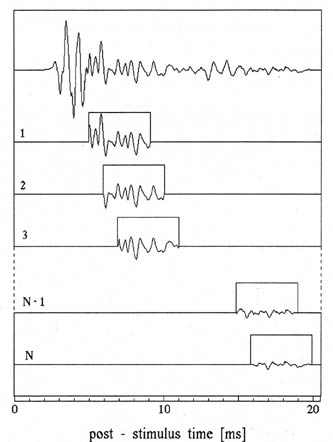
Figure 1. Schematic representation of how the STF T segments (and the IO-curves) are defined in the time domain from the whole TEOAE record (after Ravazzani et al, 1994): Each successive STFT time-window is shifted by. 1 ms. The STFT analysis starts from a time index of 5 ms to avoid the ringing artifact contamination found in the linear TEOAE recordings. To reduce possible frequency leakage effects a 5% cosine Tukey window was used in all time-windows.
Results. Whole TEOAE Record Comparison
Considering, he different cochlear saturation mechanics corresponding to stimuli of different intensity levels, one should expect that the spectra from the non-linear recordings elicited by low to mid stimuli should be different than the linear spectra, due to the different growth rates of the IO curves (see the Appendix and Fig. 9) A representative sample of the spectral dissimilarity is shown in the 3D spectral plots (spectral power, frequency, stimulus intensity) of Fig.2. Spectral differences between the linear (top graph) and the non-linear (lower graph) recordings can be seen from stimulus levels as low as 44 dB SPL . Certain low frequency components appear at higher levels only (above 71dB SPL in the linear recording plot). The overall morphology between linear and non-linear recordings seems to overlap only at mid-high stimulus levels.

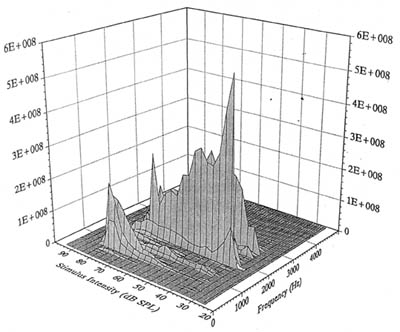
Figure 2. Representative examples of the spectral differences between (A) linear and (B) non-linear TEOAE recordings. The z-axis shows relative spectral power. As it is expected most of the spectral differences are observed in the low to mid stimulus range (a consequence of the different growth rates of the IO curves -see the Appendix for further details).
The spectral similarity of the non-linear TEOAE recordings at various stimulus intensities, was evaluated by multiple spectral correlations. A plot of the mean spectral correlation for the stimulus range of 50-80 dB SPL is presented in Fig. 3. Data below the stimulus level of 50 dB SPL have been omitted due to the low S/N ratio of the non-linear recordings. The plot shows relatively high mean correlation values ( > 70 %) across all stimulus intensities, but these estimates are quite misleading as it is suggested by the range of the error bars. The highest degree of spectral dissimilarity, was observed mainly at high stimulus levels (> 71 dB SPL). This dissimilarity was partially attributed to the presence of the ringing artifact in the linear recordings, because the error bars also indicated a large fluctuation of the correlation values in the mid-stimulus region (50- 55 dB SPL).
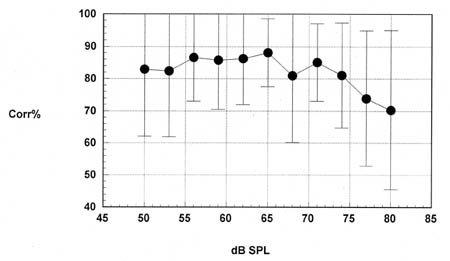
Figure 3. Mean spectral correlations between the two recording methods in the stimulus range of 50 -80 dB SPL. The error bars are computed from the mean ¹ 1 s.d. The y-axis starts from a 40% value to enhance the details in the 70%-90 % correlation range. The. plot indicates that the largest dissimilarity is observed in TEOAE recordings evoked from stimuli > 71 dB SPL.
A spatial correlation analysis of the data suggested that the linear recordings elicited by stimuli above approximately 59 dB SPL, contain spatial patterns that could be related to the presence of a ringing artifact (the mean spatial reproducibility started declining at that level). To determine the contribution of the ringing artifact on the observed spectral dissimilarity, the distribution of the spectral correlation at three different stimulus levels (59, 68 and 80dB SPL) was calculated and it is presented graphically in Fig. 4. We expected that the linear and non-linear spectra from the 59 dB SPL level would demonstrate a high degree of reproducibility (similarity). Under the assumption that the ringing artifact was the dominant factor causing the spectral dissimilarity at high stimuli, we also expected a low spectral reproducibility between the linear and the non-linear spectra from the 80 dB SPL stimulus level. The spectral similarity at the intermediate level of 68 dB SPL was used as a control . Since the TEOAE data were recorded under ideal conditions, we selected an arbitrary correlation value of 76% to represent a correlation threshold (minimal acceptable similarity) Correlation values that were below 20% ( 1 case) were not included in the graphs.

Figure 4. Spectral correlation histograms at three stimulus levels. The vertical lines in the three plots are indicating the level of the correlation threshold criterion (76%). The plots suggest that the effect of the ringing artifact on the linear data is mild, because recordings elicited by low and high stimuli produce al-most similar results ( 8 vs 7 subjects above the spectral correlation criterion).
The data from the 59 dB SPL level show that only 8 (62%) subjects produced TEOA.E responses with a spectral correlation above the 76% criterion. At the stimulus levels of 68 and 80 dB SPL, 7 (54 %) subjects produced TEOA.E responses above the correlation threshold. The spectral correlation histogram from the 80 dB SPL stimulus level showed a gap at the high-end of the data distribution and subsequent spectral analysis of the six cases, below the 76% criterion, indicated that the linear and the non-linear spectra were quite different. Linear spectra from Z subjects showed frequency components that could have been enhanced by the spectral envelope of a ringing artifact (low frequency peaks in the 1.0 -1.7 kHz region). For the other 4 subjects the spectral peak of the linear recording was located at a higher frequency, than the corresponding peak of the non�-linear recording. Analysis of the TLOAE spectral microstructure (for every 2 FFT coefficients or every 97.6 Hz) revealed that all the important frequency. components (within the dynamic range of 50dB) existed in both linear and non-linear recordings, but with different spectral magnitudes. The data suggest that the effect of the ringing artifact on the 80 dB recordings is mild because: (a) in 7 cases the spectral reproducibility was high and {b) in 4 cases the spectral dissimilarity was caused possibly by the operational characteristics of the non-linear method. This conclusion is also supported by the fact that the number of cases passing the correlation criterion did not change substantially (8 cases vs 7) from the 59 to the 30 dB SPL stimulus recordings (the data in the correlation histograms were consistent, that is the majority of the cases that passed the criterion at 59 dB SPL, passed the criterion at 8O dB SPL as well).
These observations suggest that there are at :east two main mechanisms responsible for the observed spectral dissimilarities. At high stimuli the differences are probably caused by an overlap of the spectral properties of the ringing artifact and the differential operational characteristics of the non-linear method. At mid stimuli the differences have to be attributed to the second mechanism.
Differences at Low Level Stimuli
Low level linear click sequences are eliciting TEOAE responses with not races of a ringing artifact. We hypothesized that the spectral differences between linear and non-linear recordings at low level stimuli were primarily generated by the lower number of effective click stimuli per sweep (1dierential response from the 3-1 clicks) used by the non-linear method. As a consequence the TEOAE responses demonstrate a higher level of noise N (fewer signal averages) and the overall S/N is lower in comparison to the S/N from a linear recording.
We collected normative data from six subjects, with an IL0 protocol (4X) that equalized the number of clicks in both recording methods. The TEOAE responses were elicited by stimuli of 35-50 dB SPL ( in 3 dB steps) and the non-linear recordings were generated from averages of 1040 repetitions. We have assumed that the noise embedded in the TEOAE signals had a random nature. We expected chat if the number of effective averages was the dominant factor responsible for the observed spectral differences, then the corrected non-linear protocol should produce results similar to the corresponding linear method.
Representative results of the spatial statistics from two subjects at a 35 dB .stimulus level, where the linear recordings demonstrated no traces of ringing artifacts, are shown in Table 1 (see also Fig. 10 in the Appendix for the low level IO curves of subject VM). For both subjects the estimated linear S/N ratio is larger than estimated non-linear S/N ratio and the spatial correlation (between segments of the traces A and B, as seen on the ILO screen) clearly indicated that the linear recordings contained lower levels of noise. Similar results were observed in the other four subjects.
In terms of cross-spectral estimates, three subjects yielded the same spectral peak with both recording methods. Representative data from a spectral correlation analysis in bands of audiological importance (0.5 -1.59 kHz and 1.6 - 3.19 kHz) are presented in Table 2.
The spectral correlation estimates suggest that the linear and the non-linear recordings are not well correlated at a stimulus level of 35 dB SPL. Similar results were observed at the next stimulus intensities, but the spatial and spectral correlations were slightly higher in all six tested subjects, due to the higher stimulus levels. These results suggest that the spectral differences between the linear and the non-linear recording methods, at low level stimuli, cannot be attributed to the number of effective clicks. By using this conclusion in conjunction with the information from Fig. 10a and Fig. 10b (see the Appendix) we postulate that the mechanism causing the spectral dissimilarity depends : (a) on unsaturated TEOAE segments that give rise to different growth rates of the 10 curves at various stimulus levels and (b) on the differential protocol of the non-linear recording method.
| Subj. | Lin S/N (dB) |
n-Lin S/N (dB) |
Lin-Corr 5-9.99 % |
Lin-Corr 10-9.99 ms % |
NLin-Corr 5-9.99 ms % |
NLin-Corr 10-14.9 ms % |
|---|---|---|---|---|---|---|
| MM | 4.373 | -1.86 | 86.3 | 80.9 | 68.9 | 54.9 |
| VM | 2.232 | -2.26 | 50.2 | 81.8 | 21.4 | 29.0 |
Table 1. Comparative correlation results between linear and non-linear recordings at 35 dB SPL. The non-linear data are composed of averages of 1040 sweeps (4X). The correlation values are computed from 5 ms segments to indicate (with a higher precision than the ILO estimates) the TEOAE zones, within the 20 ms recordings, that demonstrate a high correlation. In addition, Figure10 shows the saturation process at low to mid level stimuli of the 5-10 and 10-15 ms TEOAE segments. A negative value of the S/N indicates that the level of noise (computed from the difference of traces A and B) is higher than the signal.
| Subj. | Linear Peak (Hz) |
n-Lin Peak (Hz) |
0.5-1.59 KHz % |
1.6-3.19 KHz % |
3.2-4.8 KHz % |
|---|---|---|---|---|---|
| MM | 1850 | 1850 | 43.81 | 17.04 | 34.44 |
| VM | 1850 | 950 | 47.49 | 14.12 | 29.39 |
Table 2. Comparative spectral results between linear and non-linear responses. The non-linear responses were produced by averages of 1040 sweeps (4X).The spectral correlation is computed in three frequency bands, to indicate the frequencies that correlate best. In these two examples the calculated spectral correlation was low due to the fact that the spectral TEOAE structure from the corresponding linear/non-linear recordings was different specially at frequencies above 1.6 kHz.
To demonstrate the combined effect or these two factors we present the following theoretical computation. From data points of the linear W1 curve (5-10 ms) in Fig. 10b, it can be shown that the estimated value of the non-linear response at the stimulus level, of 38 dB SPL should be: 50 (value at the 38 dB SPL level ) +50 +50 - 122 (approximate value at the 48 dB SPL level) =28 ¾Pa. The estimate of the non-linear Wl curve at the 38 dB SPL level (see Fig. l0a) reads approximately 35 ¾Pa ( 28 ¾Pa + noise) , a 0.7 value in comparison to the estimate from the linear recording.
The proposed mechanism affects the non-linear recording in two ways : (a)reduces the value of the S/N and (b) alters the recording's spectral content. The latter is clearly demonstrated in Fig. 5,. which shows cross-spectra from linear and non-linear recordings (subject VM) elicited by stimuli of 38 and 47dB SPL, We use the linear spectra from the level of 47 dB SPL as an approximation to the spectra from a 48 dB SPL stimulus (corresponding to the fourth inverted click) . The reader can observe that the linear spectra from the 38 {Fig. 5a) and 47 ( Fig. 5b) dB SPL stimuli are different not only in terms of magnitude but also in terms of the frequencies of the main spectral peaks. Fig. 5c shows the non-linear spectrum obtained from a stimulus of 38 dB SPL. The main spectral peak of 1.4 kHz is shifted by approximately 100 Hz (in comparison to Fig. 5a) while the 1.8 kHz peak appears shifted and attenuated at least 2X in relation to the main peak. Clearly Fig. 5c is not the algebraic difference between Fig. 5a and Fig. 5b.
Short-time FFT analysis provides a better overall picture of the spectral microstructure of the TEOAE signals but with a loss of frequency resolution. In contrast to the 48.8 Hz resolution of the IL0 recordings, the STFT provides spectral estimates at 195.2 Hz steps, since the analysis window contains 128 data points.
The presentation of data follows the format of the previous section on Full-record analysis. To illustrate and highlight the spectral dissimilarities between the two recording methodologies 3D plots are shown from the TEOAE segments considered as unsaturated (5-10 ms) and saturated (11-16 ms).
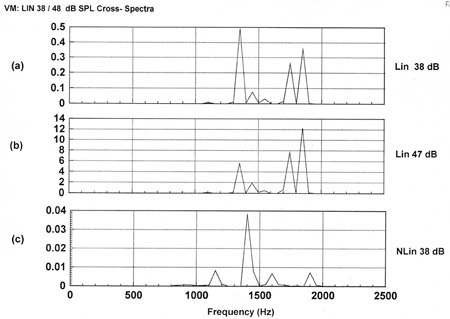
Figure 5. Cross-spectra from linear and non-linear recordings (subject VM) elicited by stimuli of 38 and 47 dB SPL. The y-axis shows relative spectral power. The linear spectra are shown in (a) and (b) and the corresponding non-linear spectrum in (c). Considering the effect of ambient noise as minimal the spectrum in (c) is not the algebraic difference between (a) and (b).
Results from the STFT Analysis
Figure 6 (data from 5-10 ms) shows the linear growth of a spectral peak around l.3 kHz in both the linear and the non-linear recordings. It is possible that this component corresponds to a TEOAE frequency enhanced by the ringing artifact. The non-linear recording is scaled up by a factor of 3 in order to reveal two other low frequency spectral components that not appear clearly in the linear recording. We postulate that these components are not artifacts, but simply frequencies 'favored' by the non-linear methodology due to the behavior of IO curves (see the Appendix). The shape of the dominant spectral peak at 1.5 kHz (growing curve) suggests that this TEOAE segment does not experience strong saturation effects even at high stimulus levels.
Fig. 7 shows data from the saturated segment ( 11-16 ms). The max spectral amplitude around 1.5 kHz, seems to be produced by different intensity stimuli the linear and the non-linear recordings (47 and 57 dB SFL respectively).The declining shape of the spectral curve is in accordance with the hypothesis that this TEOAE segment is a saturated region for high level stimuli.
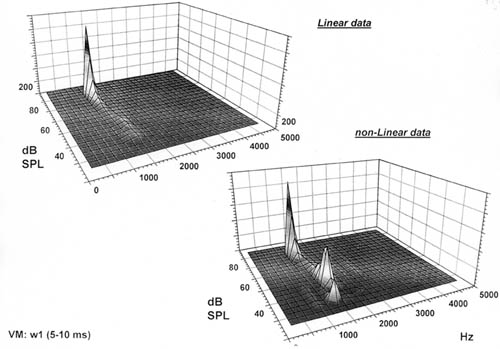
Figure 6. Comparison between the linear and the non-linear recordings from the unsaturated TEOAE segment (W1= 5 -10 ms), The z-axis shows relative spectral power which is scaled down by a factor of 103. The STFT is computed from 128 data points using a 5% Tukey window. The non-linear spectra show low frequency components which do not show in the corresponding linear data plot. The main peak at 1.4 kHz is visible in both plots.
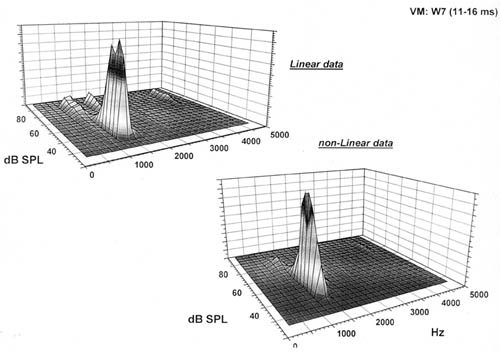
Figure 7. Comparison between the linear and the non-linear recordings from the saturated TEOAE segment (W7=11-16 ms). The z-axis shows relative spectral power. The linear spectra demonstrate two peaks approximately at 1.0and 2.0 kHz which are not visible in the non-linear spectra. The main peak at 1.4 kHz is visible in both plots.
The majority of the subjects demonstrated similar patterns and the highest spectral similarity, between linear and non-linear recordings, was found in the saturated TEOAE segment (11-16 ms). Fig. 8 shows the mean STFT spectral correlation values, between the linear and the non-linear recordings, in a stimulus range 50-80 dB SPL. Levels below 50 dB SPL were omitted due to the poor S/N ratios of the non-linear recordings. The plot of the W1 segment shows that acceptable correlation values (>76%) appear above stimulus levels of 71 dB SPL. The plot of the saturated W7 segment shows that acceptable correlations exist above stimulus levels of 62 dB SPL. Subsequent correlation histograms at the stimulus levels of 60 and 62 dB SPL identified a small number of outliers (two subjects). Removal of these subjects resulted in an acceptable spectral reproducibility from stimulus levels as low as 60 dB SPL. These results suggest that data from TEOAE saturated regions, recorded with any of the two recording protocols, will maintain the integrity of the spectral information.
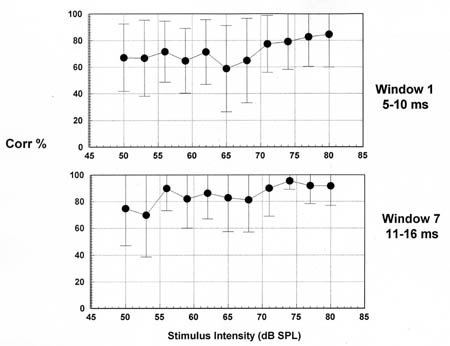
Figure 8. Mean spectral correlation values from the W 1 and W7 TEOAE segments: or a stimulus range of 50-30 dB SPL. The error bars are computed from the mean ¹1 s.d. The data from window 7 indicate that when the TEOAE responses are saturated the spectral similarity between the recording methods is high.
Disscusion
The whole-segment {0-20 ms) and the STFT (5-16 ms) TEOAE spectral analysis resulted in different interpretations of the spectral similarity between the linear and the non-linear recordings. The STFT results indicated that acceptable spectral correlation values can be expected from responses elicited by stimulus levels as low as 60 dB SPL. On the contrary, the whole-segment analysis indicated that responses elicited by stimuli above 71 dB SPL produce lower correlation values which cannot be attributed to the existence of the ringing artifact.
The correlation values in the whole-segment analysis include additional in-formation from the 2.5-5.0, 10.0-11.0 and 16-20 ms TEOAE segments. The latter two can be considered as saturated regions and it is unlikely that contribute to the spectral dissimilarity {high value of the correlation variance) shown in Fig. 3. Therefore we speculate that the differences. between the STFT and the whole segment analysis are generated by the spectral contents of the 2.5 - 5.0 ms segment. This hypothesis was supported by an extra set of IO normative TEOAE data ( 18 adults with mean age 27.2 ¹ 2.1 years) in which 11 subjects (61.1°%) demonstrated responses with signs of a mild saturation at stimuli > 77dB SPL, in the 5-10 ms segment. Considering the tonotopical mapping of the cochlea in relation to the temporal structure of the TECAE recordings (early TEOAE segments are highly correlated with high frequency cochlear TEOAE generators) we have considered that the 2.5-5.0 ms segment in the IO data was probably unsaturated or mildly saturated.
We postulate that the observed spectral dissimilarities between the two recording techniques, at stimuli approximately > 71 dB SPL, are caused by the combined effect of : (1) a mild ringing artifact which affects the linear recordings and (2) the unsaturation of the early TEOAE segments (2.5- 10 ms). The dominance of one factor over the other depends on the functional status of the cochlea which is subject dependent, but our data have suggested that the second factor has a greater impact on the resulted spectral dissimilarity. We conclude that from a systemic perspective the two recording methods record different aspects of the TEOAE signals.
Clinical Consequences of the Observed Spectral Dissimilarities
(1) What we record, with the ILO default settings, from a normative population (including neonates) is a "derived" aspect of the cochlear function, since the non-linear recordings represent a differential signal produced from different cochlear saturation mechanics. Obviously this differential distortion is minimized as we use stimuli higher than 80-85 dB SPL (all clicks of the stimulus train produce saturated responses). Since the non-linear method uses information from two different cochlear saturation levels, the frequency content (mainly the peaks) of the TEOAE responses will fluctuate, because in clinical conditions it is unknown which cochlear level dominates in terms of TEOAE frequencies. This may have an effect on long-term monitoring applications and on neonatal screening. For the latter, the ILO equipment generates an attenuated click which is 19.5 dB lower that the actual ILO setting. This ensures that the non-linear recording will contain linear components and will produce a spectrum that will be related to the spectral differences between two unsaturated levels.
(2) The high similarity between the linear and the non linear spectra at mid stimuli ( 60 -65 dB SPL) suggests that linear TEOAE protocols can be used to assess the cochlear function from a normal population, but new statistics ( i.e. the statistical values we use in neonatal screening) have to be computed. From our experience linear protocols based on mid-level stimuli do not generate good TEOAE recordings from hearing loss subjects and for universal applications (detecting normality and hearing impairment- see Hatzopoulos, 1994) these protocols may not be suitable. Nevertheless the (in ear protocols appear to more stable because the recorded responses originate from the same cochlear saturation mechanics (one stimulus level for all clicks). One disadvantage of the linear method is that the ringing artifact, which does not appear to be a critical parameter in the normative TEOAE recordings, may present a problem incases of hearing loss. In these cases the presence of the artifact can be considered as a TEOAE response, but according to our experience a TEOAE spectrum that contains few discrete frequencies is always considered a suspicious normal case.
(3) It is difficult to evaluate the effect of the non-linear stimulus protocol on neonatal screening because in strict screening terms it may not be important whether the recorded TEOAE sequence is a derived form of the original cochlear response (as long there is a detectable TEOAE-related signal). We believe that a new protocol, based on mid-level linear stimulus sequences (65-69dB SPL), utilizing an analysis method to bypass the ringing ¹a-tifact contamination could be a more successful screening procedure, because the re-corded signals will be characterized by higher S/N ratios and higher response detectability. Furthermore the fact that the ILO equipment attenuates the click stimulus in neonatal applications by 19.5 dB SPL,. ensures the absence of a prolonged ( > 3.0 ms) ringing artifact in the linear TEOAE recordings. It a conceivable that a 80 dB linear click sequence may serve better the screening objectives, but these are issues which require more detailed investigations.
Appendix
Input - Output (IO) curve fundamentals
The collection of multiple TEOAE recordings from various click stimuli offers the possibility to construct a macromechanical view of the cochlea as seen from a TEOAE-perspective. The exact. IO methodology has been presented in a number of references (Ravazzani and Grandori 1990, 1994; Hatzopoulos; 1994) and works as follows. Every TEOAE recording is calculated the average of the Even and Odd sweeps (buffers A and B. as seen on the ILO screen), then it is divided in a number of segments and for every segment the root mean square (RMS) value is computed. A n-stimulus level protocol with 11 segments per level (the time-duration of the W 1- W11 segments is presented in the Methods section) produces a n x 11 RMS matrix or 11 IO curves of n points each . The change of RMS value across two or more stimulus levels (or more precisely the change of a curve's slope) can be used as a saturation indicator for a particular segment. For example, if the RMS value tend to stabilize or to oscillate around a specific value, we assume that the corresponding segment is saturated (under the hypothesis that the recorded TEOAE sequences had good S/N ratios). If the RVIS value tends to increase we assume that the segment is not saturated. For this study 16 levels of stimuli were used per subject, resulting in a 16 x11 matrix. Fig. 9 shows a representative IO plot from the non-linear recordings used in Fig. 6 and Fig. 7 (STFT plots) in the stimulus range 35 to 80 dB SPL. Fig. 10 ( a, b) shows a blown-up behavior of IO curves at low level stimuli(obtained with a 4X non-linear and linear protocol).
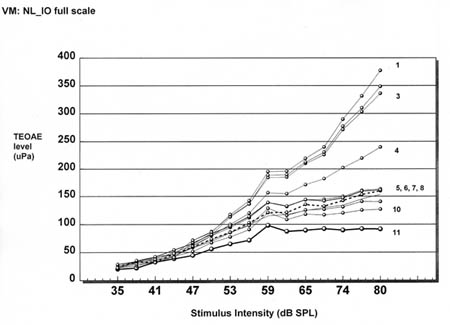
Figure 9. Input-Output curves from normative non-linear recordings (subject VM). The numbers at the right hand side indicate the corresponding TEOAE segment (for the time index details see the Methods section). The segments W5-W 11 seemed to be saturated above stimuli of approximately 59 dB SPL, where the segments W1-W4 do not demonstrate a saturated behavior even at 80 dB SPL.

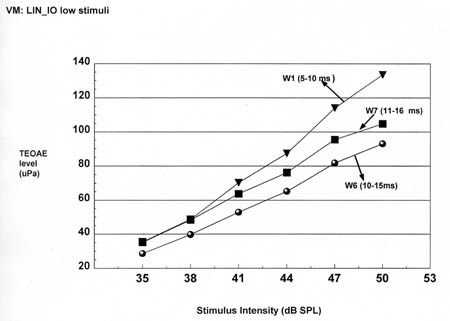
Figure 10. (a) Input-Output curves from normative (subject VM non-linear and (b) from linear recordings, showing the saturation process for the W1 (5-10 ms) W6 (10-15 ms) and W7 (11-16 ms) windows, in the stimulus range of 35 to 50 dB SPL. The information from the first two windows can be used in conjunction with the estimated spatial correlation values in Table l.
The reader can observe that in Fig. 9 the IO curves from segments W 1 toW4 are quite apart, demonstrating no evident signs of saturation even at 90 dB SPL (the fourth click is ideally set at 80 + 10 dB SPL). Saturation is observed in segments W5 ( W5= 9-14 ms) to W11. The latter shows an ideal saturated behavior possibly influenced by the higher levels of noise observed in the latter portions of the TEOAE recording. The IO-curves of Fig. 9 imply that the non-linear method will elicit TEOAE recordings with spectra demonstrating a fluctuating variance (in terms of dominant TEOAE frequencies at mid to high stimuli). This will be caused by the different saturation mechanics corresponding to the different levels of the positive and negative clicks in the stimulus train. The linear growth of the curves in Fig. 9 (W 1 to W4) suggests that the non-linear data contain linear components. The effect of the forth click seems to manifest as a linear 'residue' (a differential linear component) caused by the asymmetry of the IO curves. The macroscopic nature of these curves undoubtly simplifies the cochlear mechanics involved, because every component of the lumped system is considered ideal. For example, we are aware that the negative polarity click is not an exact 3X replica of the positive clicks in terms of frequency response but these non-linearities were considered as having a minimal impact on the recording sequences.
References
- Hatzopoulos, S. (1994). Classification of Hearing Loss Disorders using TEOAE-based descriptors. Ph.D. dissertation, Worcester Polytechnic Institute, .USA, .
- Grandori, F., Ravazzani, P. (1990). Deconvolutions of Evoked Otoacoustic Emissions and response non-linearity in: F. Grandori, G: Ciafrone and D.T. Kemp (Eds): Cochlear Mechanisms and Otoacoustic Emissions, Karger, 99-109.
- Granciori, F., Rvazzani, P., Tognola, G., Hatzopoulos, S. (1994). "Derived Nonlinear" versus "Linear" Click-Evoked Otoacoustic Emissions. in : R. Thornton and F. Grandori {Eds): Advances in Otoacoustic Emissions - Vol I: Recording Techniques for Otoacoustic Emissions, 48-64.
- Kemp D.I., Ryan, S., Bray P. (1990). Otoacoustic Emission Analysis and Interpretation for Clinical Purposes, in : F. Grandori, G. Ciafrone and D T. Kemp (Eds): Cochlear Mechanisms and Otoacoustic Emissions, Karger, 77-98.
- Prieve, B.A, Gorga, M.P., Schmidt, A., Neely, S., Peters, J., Schultes L., and Jesteadt, W. (1993). Analysis of transient-evoked Otoacoustic emissions in normal-hearing and hearing-impaired ears. J Acoust Soc Am , 93, 3308-3319.
- Rabiner, L.R, Allen, J.B. (1978). Digital Processing of Speech Signals. Englewood Cliffs, NJ, Prentice Hall Inc.
- Ravazzani, P., Grandori, F. (1994): Evoked Otoacoustic Emissions: Non-linearities and response interpretation. Trans Biomed Eng , 40; 500-504.
- White, K.R, Vohr, B., Behrens, T.R (1993). Universal Newborn Hearing Screening Using Transient Evoked Otoacoustic Emissions: Results of the Rhode Island Hearing Assessment Project. Seminars in Hearing, 14,18-29.Zwiclter, E. (1978). A model describing non -linearities in hearing by active processes with saturation at 40 dB. Biol Cybernet, 35, 243-250.




